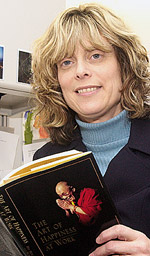|
Campus News
UAlbany�s Loscocco
Enhances �Happiness at Work�
by Greta Petry
 |
| Karyn Loscocco |
A new book on business by the Dalai Lama and
Howard C. Cutler, M.D., The
Art of Happiness at Work (Riverhead Books),
cites the research of University at Albany sociologist
Karyn Loscocco.
The book is a series of conversations between
Cutler and the spiritual leader of the Tibetan
people, and is a sequel to The
Art of Happiness: A Handbook for Living,
which spent almost two years on The
New York Times bestseller list.
According to Happiness at
Work, research on job fulfillment finds
that most people fall into one of three categories:
- Those who view their job as simply a means
of making a living.
- Workers who are entirely career-driven. Status,
title, and power are at the core of their striving.
- Employees who view their job as a calling,
as a way of helping other people. Researchers
found workers in this category are happiest,
as their self-worth is not as closely tied to
title, salary, or what others think of them.
Loscocco, an associate professor who joined the
UAlbany faculty in 1985, said, �My studies of
job satisfaction and well-being do support the
view that when work is seen as a calling it will
bring happiness.� At the same time, she said,
not everyone has the same chance to find meaning
on the job. �I came to the study of job satisfaction
from the perspective of social inequality. I am
concerned about the obstacles some groups face
in trying to derive more meaning from the work
that they do.�
The Cutler book, published in 2003, cites research
findings from studies the UAlbany sociologist
conducted in the late 1980s and early 1990s. One
of her first articles contested the accepted notion
that factory workers willingly trade off challenging
and interesting work in order to get more money
and better fringe benefits. Through observation,
interviews, and analyses of survey data from 3,637
midwestern factory workers (results published
in the February 1989 issue of Work
and Occupations: An International Sociological
Journal), Loscocco found that meaning was
often structured right out of tasks an employee
would otherwise find meaningful; that employees
were very creative about finding ways to challenge
themselves at work; and that they wanted what
other workers have � jobs that are intrinsically
rewarding and paid well.
In her studies of gender and work, Loscocco moved
toward models that included family. �It became
clear to me, as others were saying, that paid
work and family lives are connected in a single
gendered system. How can we understand people�s
happiness at work without knowing something about
the rest of their lives?�
Loscocco believes that a key aspect of the work-family
system is conflict or imbalance, and much of her
more recent work examines this. Loscocco said
the �main source of work-family conflict is the
erosion of the gender division of labor.� Though
women of color and white women of limited means
have always worked for pay, the influx of white
middle-class women into the labor force (even
those with young children), has led to only a
small minority of families having an employed
husband and a stay-at-home wife. �Yet work institutions
lag behind, continuing to organize work using
the model of the male married worker who has a
buffer at home managing his personal life so that
he can devote himself to paid work,� she said.
Not only has the husband lost his buffer, the
working wife never had one, and the single parent
manages the demands of work, child care, housework,
and finances alone.
In an article published in The
Gerontologist in 2000, Loscocco proposed
a new model of �age integration.� She wrote, �Ideally,
a society in which people intersperse education,
work, and leisure over the course of their lives
is one in which role strain and role overload
at midlife can be dramatically lessened.�
Education and training would continue through
life. Flextime, job sharing, and leaves would
be available for employees in all kinds of jobs,
not just for the privileged. This would help reduce
unemployment as paid work opportunities would
be distributed more evenly. Loscocco is proposing
an �ideal type,� but her article provides an interesting
approach to the problem of the structural lag
affecting working people.
With a National Science Foundation grant of $184,433,
she conducted The Upstate New York Small Business
Study � face-to-face interviews with 643 self-employed
women and men� in which one of her questions is
how people negotiate their work and family lives
while they await larger societal change. The study
looks at how much time people give to paid work
and family, and how that affects work-family balance
and personal well-being. She is analyzing the
extent to which people make tradeoffs between
economic success and happiness, and whether men
and women have similar patterns, given men�s continued
pressure to provide for their families. Loscocco
and colleague Glenna Spitze are looking at incongruence
between attitudes and behavior about family responsibilities
caused by structural lag.
Until American corporations catch up to the vast
social changes in the family, one can find happiness
at work by following the Dalai Lama�s simple advice
to pay attention to basic human relationships.
�Be a good person, a kind person. Relate to others
with warmth, human affection, with honesty and
sincerity. Compassion,� he told Cutler.
|
